Around The Oval
Checking out the new “M”

Photos by Todd Goodrich
If you look closely at the “M” on Mount Sentinel, you’ll notice an increased clarity. The University landmark has a new whitewash and a spanking new, foot-deep, maroon outline, thanks to UM’s Grizzly basketball team. The painting project is part of a larger plan, according to Head Coach Larry Krystkowiak. As part of the coach’s team-building efforts, his players now live on campus and are making new friends, becoming more involved with University life—and giving something back. “We know how supportive the students are for our team,” says Krystkowiak, “so we wanted to do a little bit in turn for them.”
Let’s take a look at the new M from closer range.
It’s hot, I’m still on Switchback One, and it’s taking forever. Is it me, or is the first “zig” of the trail a little—no, a lot—longer than the others? Buck up, girl, I think, and I forge on like a plow horse.
Passing a three-child family I stare in astonishment. The mother carries an infant in a backpack. Her husband, with a red-faced toddler riding his shoulders, urges the oldest child, a disillusioned towhead, up the mountain, hollering “You’re almost there, Jeremy!”
In your dreams, kid.
The Rattlesnake valley yawns out in front of me as I trudge up number four, and I sneak a look at the view before zagging onto five. Ahead, I see one of the trail’s two resting benches. On it—taking up all the room, I might add—are three young women in Grizzly T-shirts, chugging from their water bottles. “Hello, ladies,” I say, in what I hope is a robust tone of voice. I surreptitiously blot my sweating forehead with a pink bandanna. Bench? I don’t need a bench.
Number eight and my quads are shakin’. A man and woman in their seventies, both carrying varnished walking sticks, nod at me as we pass. Then a giant, bare-chested stork of a boy comes flying down the mountain, stopwatch clutched in his hand. Slow down, mister! For the love of—uh-oh, here it is: the dreaded number eleven. Switchback Eleven is to M climbers like what “the wall” is to marathon runners.
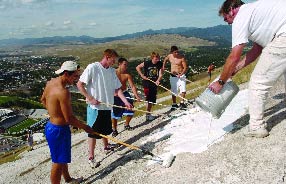 UM's basketball team brightens up the M. The project was the brainchild of Bob O'Conner '49, who poured the first concrete for the letter in 1968. He pitched the idea to President Dennison, and Coach Krystkowiak took up the challenge. |
Chuff, chuff, chuff. Whose bright idea was this, anyway? I’m muttering. The second resting bench beckons like an oasis, and my plan is to fling myself onto it—until I notice a woman about my age fast-walking down number twelve.
“You go, girl!” she says, all hale-and-hearty. “You’re almost there!” You go, girl. Hmmph. Why is it that folks, the instant they’re heading down the mountain, become insufferably smug?
I’m on thirteen—closing in—and then, at last, fourteen. I can almost hear Rocky’s Theme wafting through the air. And there’s the behemoth, the M, bordered with its new, glossy, maroon stripe. Spectacular. Thank you, basketball team. Go, Griz!
My spirits soar as I stand gazing at campus, nestled under a nimbus of soft, multi-colored treetops. I could kiss the sky.
After tapping the M’s base for good luck, I turn and head back downhill. At number ten I pass a pack of teenage boys; they look a little flushed. A grin—an honest, spontaneous grin—creases my face as I give the young men a thumbs-up.
“Way to go, boys!” I yell. “You’re almost there!” – Paddy MacDonald
The President's Corner
Too soon we forget what it means to embark on a new adventure. I have no doubt that the UM graduates who volunteer for the Peace Corps will never forget the experience. It strikes me as quite significant that a large percentage of our graduates accept the Peace Corps challenge, showing once again the capacity of the Montana experience to prepare people for engaged and meaningful lives. The University is included in two national rankings: The Princeton Review’s listing of “engaged campuses” and Forbes’ listing of the ten “IQ Campuses.” This is reflective of our effort to provide an education second to none. No matter how much money we spend, we can never equal the impact that such rankings have. Moreover, rankings similar to these reveal something truly important about the character and effect of the education and the efforts of students to get the most out of the experience.
In my state of the University address in September, I invoked the old adage that the quality of every experience depends upon the intensity of our engagement. This insight applies particularly to education and learning. In addition, as we engage learners in the process, we no longer have to concern ourselves with either faculty or student productivity. No doubt, everyone has vivid memories of at least one learning experience or adventure made indelible because of intense engagement. At this University, we strive to achieve that objective in all we do. See you soon!
George Dennison ’62, M.A. ’63
President
Life Long Learning
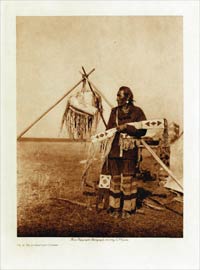
“Allow us to tell our story …”
Amid all the hoopla of the Lewis and Clark bicentennial, it’s refreshing to hear the voices of the descendants of the Indian tribes who were as responsible for the success of the Corps of Discovery as the members themselves. Without their food, shelter, and willingness to trade, the Corps would have perished in what they considered wilderness. Those living in these lands considered them “beloved homelands.”
UM’s Lifelong Learning Project has produced Native Homelands, an impressive documentary of voices of all the tribes that lived along the Corps’ route. The thirty-minute video provides a look at each tribe, opening with lush photographic stills of the homelands and chanting in each language; it features members of each tribe who tell stories that were handed down to them.
Much can be learned from these voices; for instance, a member of the Chinook tribe talks of how Lewis and Clark “always were approaching the wrong people” in their attempts to trade. They looked for a male chief, when the women of the tribe were responsible for all trade. A woman of the Hidatsa tribe talks about images that show a woman carrying a large bushel of corn on her back and a man walking behind her. “They make the women look like slaves,” she says. But what was really happening is that the man didn’t carry the corn because he needed to be able to protect the woman and the corn. The women, however, “owned everything and were the traders for the tribe.”
A member of the Blackfeet tribe talks about the tribe’s reverence for the beaver because it was capable of building its own environment and describes how the early hunting of beaver by people of European descent was a harbinger of what was to come. The video will be available for purchase from UM’s Continuing Education program.
From Behind the Scenes to Center stage
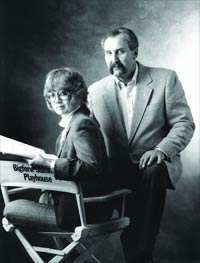
It was 1964 and music major Jude Irvin was sitting in the University Theatre watching a band rehearsal. She couldn’t help but notice a disgruntled student moving up and down the aisles. He was trying to build a stage set and the music rehearsal was definitely hindering his progress. Fast forward forty years and you will find that the chance 1964 meeting of two School of Fine Arts students has produced one of the most well known theatrical couples in the Northwest.
Music alumna Jude Irvin Thomson and drama alumnus Donald Thomson, MA ’66, have been entertaining Montanans and visitors from all over the world at the Bigfork Summer Playhouse since the summer of 1964.
Although Don and Jude have spent their years behind the scenes, on Saturday, April 2, they will be center stage at the University Theatre, honored as the featured alumni for UM’s School of Fine Arts fifth annual Odyssey of the Stars—A Celebration of Artistic Journeys. A popular event benefiting the School of Fine Arts scholarship fund, the program features fine arts alumni who have gone on to successful careers in the arts, in concert with current students who dream of such careers. Odyssey 2005 will feature UM and Bigfork Summer Playhouse alumni and more than 200 outstanding UM student performers.
Drum Beat For a New Center
President George Dennison has articulated UM’s commitment to enroll more American Indian students since he came to campus fourteen years ago. And efforts are paying off, with UM now enrolling the most American Indian students of any campus in the state. Privately funded initiatives have emerged from many quarters to support UM’s American Indian projects, and plans are under way to build a new Native American Studies Center.
Construction of the center, to replace a 1920s-vintage former private home that now houses Native American Studies, was authorized by the 2001 Montana Legislature. Among the first to contribute to the project was the family of Terry ’63 and Patt Payne of Missoula. Terry Payne says he hopes the family’s $500,000 gift will serve as a catalyst for advancing the project.
Jed Liston, assistant vice president for Enrollment Services, says having the center will help UM recruit native students. “We know that American Indians face tremendous adjustment when they leave their homes. This center will help our recruitment and retention efforts by giving Native American students a welcoming, supportive, family-like environment on the UM campus,” he says.
The project is clearly close to Dennison’s heart. “What makes this project imperative to me is that we are located in the heart of Indian Country and have an obligation to make a difference for Native American students,” he says. “Having a center will provide us a better foundation for programs that benefit us all.”
The center is only one of several projects aimed at allowing the University to incorporate American Indian traditions and culture in the educational process. UM’s College of Arts and Sciences is taking a lead in the building project, but each professional school also has efforts that encourage Native Americans to pursue their fields. Three schools recently received gifts to help in these endeavors.
The School of Journalism received two gifts—$475,000 from the John S. and James L. Knight Foundation and $75,000 from the Ethics and Excellence in Journalism Foundation—to support Reznet, an online newspaper written by and for American Indian student journalists. In its third year, Reznet has already distinguished itself, winning the 2003 Native Media Award for Best Internet News Site from the Native American Journalists Association. Reznet has been fostered by UM’s Denny McAuliffe, an Osage, who is the first Native American journalist-in-residence in the country. McAuliffe previously was an editor at the Washington Post.
A former educator anonymously contributed $50,000 to establish a unique program for UM’s School of Education to help Montana teachers incorporate Native American history and culture in their curricula.
The College of Forestry and Conservation recently was approved for a $45,000 gift from the Alfred P. Sloan Foundation for its Native American Natural Resources program, aimed at attracting American Indian forestry students through a culturally relevant curriculum that focuses on the relationship between Native American traditions and values and natural resource management.
Substantial funding also has come from Toyota Motor Sales and John ’84 and Kathleen Connors of Medina, Washington, for American Indian Business Leaders, headquartered at UM’s School of Business Administration.
– Kathie Nygaard
Goodbye to all that
Our distinguished 2003 Capital One National Mascot of the Year Barry Anderson has turned his once near-volunteer job as Griz mascot into a career. He signed a contract in August with the NBA’s Chicago Bulls to be Benny the Bull and left town, after training two new Montes in the tricks of his trade. But we’re left with a haunting question.
How do you turn a bear into a bull?
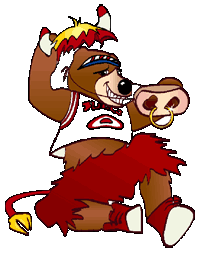
• Offer him some insider trading tips.
• Tell him he gets to earn stud fees.
• Explain how he can now have more fashionable piercings.
• Describe annual junkets to Pamplona.
• Tell him he can exchange the trash can for the trough.
• Explain that he’s likely to have lower cholesterol and better heart health.
• Give him heavy doses of Red Bull at hibernation time.
• Explain that riding the El is easier than climbing the M.
• Tell him he can start a new streak against the Bobcats—the Charlotte Bobcats.
And, perhaps most enticing:
• Now he can mentor the Cubs (but only in disguise—he’ll always be a bear to us!).
Illustration by Lindy Coon
UM’s Monte has, for the third consecutive year, been named to the Capital One All-America Mascot Team. Vote daily for Monte online at http:www. capitalonebowl.com. Polls will close December 26 and the winner will be announced January 1, 2005, at the Capital One Bowl on ABC.
From president to professor
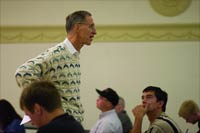
Imagine a former university president who rides his bike to work and teaches a class for free. You might be imagining former UM President James Koch. Every Tuesday night Professor Koch can be found in Gallagher Building Room L04 teaching a class on World War II history.
Sitting in his office, packed floor to ceiling with books, Koch says that after moving back to Missoula two years ago with his wife, Donna, he wanted to thank the University in some way. He says he feels it’s a good thing for people to give of themselves and their services. Although the sixty-one-year-old Koch only dimly remembers the end of World War II, he has a fascination with the connection it has to events facing the world today. “World War II was the seminal event of the twentieth century,” Koch says, adding the same types of issues persist today that did then; Arab-Americans are facing hostility in America, similar to how the Japanese-Americans were treated during the war. Koch also teaches the class at Old Dominion University in Norfolk, Virginia, where he remains an economics professor. The Kochs now live in Norfolk full-time from January through June and Missoula the rest of the year.
Koch was UM’s fifteenth president, serving from 1986 to 1990. While here, Koch increased enrollment, launched an extensive campaign to improve the University’s image, and increased the number of student activities.
He resigned his position at UM to become president of Old Dominion, where he was chosen as one of America’s 100 most effective university presidents by an Exxon Foundation study.
There are two things about teaching at UM Koch loves. He enjoys the opportunity to open doors of sophisticated urbanized education to students who have grown up in a rural environment, or what he refers to as virgin territory. “It’s really amazing how well University graduates do,” Koch says with excitement, “and most of it is due to UM.”
Koch says he also favors the informal dress code at Montana; in Virginia he rarely is seen without a suit and tie.
The former president is impressed by progress the University has made in his absence. Even though he serves as a consultant for other university presidents, he believes he should stay out of focus regarding UM’s decisions. “Former presidents should be seen and not heard,” he says.
Koch has lived in several states and in numerous countries. But he likes Missoula best because of the college-town atmosphere it provides. With the technological advances of the Internet and improved air travel, he feels it’s quite possible for him to live and work anywhere. “We thought Missoula was the best place to be,” he says.
We couldn’t agree more. – Brianne Burrowes
Fruitful Collaboration
August proved to be a lucrative month for UM scientists who, in collaboration with Montana State University, won a $13.5 million grant from the National Science Foundation’s Experimental Program to Stimulate Competitive Research, or NSF EPSCoR. The money, distributed over the next three years, will fund a multitude of science projects at both universities.
Since the 1980s EPSCoR has been helping state universities and colleges to stimulate Big Sky research and the state economy. NSF EPSCoR funding has put 250 people to work across Montana, with 115 hires for UM-related research projects and 135 for those at MSU. But it wasn’t until 2001 that Montana scientists scored a big-money grant. Since then, the program has funded the work of 964 students, seminar speakers, visiting scholars, and more at the two universities.
NSF EPSCoR also funds innovative programs such as Science is Cool, which airs on Montana Public Radio’s Children’s Corner, and Science Within Society, a lecture series held each summer in Missoula. Of the $13.5 million, $9 million comes from the NSF and the remaining amount from required matching state dollars, specifically, the Montana Board of Research and Commercialization Technology.
A top-rate example of how EPSCoR works can be found at Sustainable Systems Inc., a Missoula-based research, development, and commercialization company. Founded by Paul Miller, a UM graduate student in chemistry, the company came into existence as a result of a pilot project funded by EPSCoR. Currently, the manufacturing plant converts used vegetable oil from UM’s dining halls—the bulk of which is French fry grease—into fuel that powers two UM commuter buses.
The company now processes canola, mustard, and other oil seed crops into biofuels. Miller and the Sustainable Systems’ vice president, David Max, have begun marketing their biodegradable, non-toxic fuel to the agricultural industry, the city, and the diesel-engine retail customers. Recently, they formed a partnership with Cenex and Sustainable Systems’ B-20—twenty percent biofuel and eighty percent petroleum—is available at both Cenex locations in Missoula.
And Miller has begun to diversify. “We realized there are so many things you can make from vegetable oil besides fuel,” Miller says. “There’s motor oil, hydraulic fluid, soft greases. We can really go far from here.”
The payoff, says Chuck Thompson, Montana’s NSF EPSCoR director, will be evident. Research and development companies like Miller’s will thrive and become an anchor in the state’s economic landscape. Blue chip companies, he says, will look to Montana for a talented work pool and as a place to do business. Perhaps, Thompson suggests, with the help of EPSCoR, a new state motto will be born: Big Science Country.
Landscape of an armchair

A painting by abstract expressionist Willem de Kooning graces the lobby of UM’s President’s Office. Landscape of an Armchair, painted in 1971, is an example of de Kooning’s controversial Women series, which merged the female figure with landscape. The painting is on temporary loan to UM’s Montana Museum of Art and Culture from an anonymous private collector.